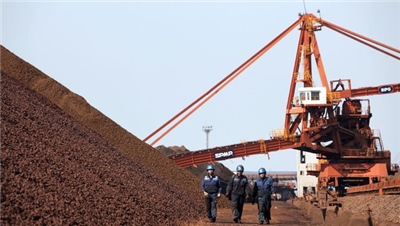(单词翻译:单击)
 No wonder China’s economy is cooling fast. In spite of Beijing’s three interest rate cuts over the past six months, the real cost of capital has surged to its highest level since the aftermath of the financial crisis as the country’s grinding deflation deepens.
No wonder China’s economy is cooling fast. In spite of Beijing’s three interest rate cuts over the past six months, the real cost of capital has surged to its highest level since the aftermath of the financial crisis as the country’s grinding deflation deepens.
难怪中国经济正迅速降温。尽管中国在过去6个月里三次降息,但随着该国令人头疼的通缩进一步加剧,其实际资金成本已飙升至金融危机结束以来的最高水平。
Not only is this anomalous in a world where about $2tn in global bonds are trading at negative yields, it is also inflicting disproportionate punishment on the weakest parts of corporate China as the economy slows.
在全球约2万亿美元债券的收益率为负之际,上述现象实属反常。不仅如此,随着中国经济增长放缓,它还对该国实力最弱的企业构成了相对而言过于沉重的拖累。
The real lending rate (the weighted average lending rate plus producer price deflation) rose to 10.8 per cent in March, its highest level since September 2009, according to a research note from Mizuho Securities in Hong Kong (see chart).
香港瑞穗证券(Mizuho Securities)发表的一份研究报告显示,中国的实际贷款利率(加权平均贷款利率加上生产者价格通缩)在今年3月升至10.8%,为2009年9月以来的最高水平。
The main impact of the higher real rates is to pile further pressure on industrial enterprises that are suffering declining profits while contending with a welter of debt service charges. In the first quarter of the year, industrial profits fell 2.7 per cent to Rmb1.25tn ($200bn), after rising 3.3 per cent during the whole of 2014 to Rmb6.47tn, according to official statistics.
实际利率上升的主要影响是,对利润不断下滑且被大量偿债支出搞得焦头烂额的工业企业构成进一步压力。官方统计数据显示,今年第一季度,工业企业利润下降2.7%,至1.25万亿元人民币(合2000亿美元),而2014年全年利润增长了3.3%,至6.47万亿元人民币。
In nominal terms, China’s weighted average lending rate was 6.56 per cent in the first quarter, meaning that companies will have to pay about $812bn in debt service charges this year on non-financial corporate debt estimated by McKinsey to have totalled $12.5tn — or 125 per cent of GDP — at the end of last year.
今年一季度,中国名义加权平均贷款利率为6.56%,这意味着企业今年得支付大约8120亿美元的非金融企业债债息——据麦肯锡(McKinsey)估计,去年底中国非金融企业债总额为12.5万亿美元,相当于国内生产总值(GDP)的125%。
But if calculated in real terms, the debt service charge on non-financial corporate debt would come to $1.35tn this year. To put that number into context, it is not only significantly more than China’s projected total industrial profits this year but also slightly bigger than the size of a large emerging economy such as Mexico.
但如果按实际利率计算,今年要偿还的非金融企业债债息将达1.35万亿美元。看下这个数字到底有多大:它不仅远远大于今年中国工业利润总额的预期值,而且还略大于墨西哥等大型新兴经济体的产出规模。
Such is the sand in the gears of China’s growth engine. Many companies are paying out more in debt service charges than they are taking in profits as deflation depresses the prices of the products that they produce. Since September last year, deflation measured by the producer price index (PPI) has deepened from minus 1.29 per cent to minus 4.24 per cent in March this year, far outstripping the 90 basis points in interest rate cuts over the same period.
这种偿债负担是中国增长引擎齿轮里的沙子。许多企业要偿还的债务利息比它们的利润还多,因为通缩压低了它们产品的价格。今年3月,以工业品出厂价格指数(PPI)变化量衡量的通缩水平,已从去年9月的-1.29%扩大至-4.24%,变动幅度远超同期的降息幅度——后者为90个基点。
What’s more, the PPI’s descent shows no sign of abating, registering a fall of 4.6 per cent in April to push real lending rates higher.
此外,PPI的下降毫无放缓的迹象,今年4月又下降了4.6%,进一步推高了实际贷款利率。
The burden of surging real interest payments falls unevenly on corporate China, penalising most harshly those companies that gorged themselves on debt in the aftermath of the financial crisis and are now suffering from overcapacity and softening demand.
实际利率飙升对中国不同企业的拖累是不一样的,受影响最大的是那些在金融危机后大幅举债、现在正遭受产能过剩和需求下滑困扰的企业。
Heavy industrial companies beset by overcapacity and a collapse in pricing power — such as iron ore mines, steel mills and some real estate developers — are in genuine distress. Shi Zhenglei, iron ore analyst at consultancy Mysteel, estimates that about half of China’s 1,500 iron ore mines will be forced to close this year.
受产能过剩和定价能力骤降困扰的重工业企业——如铁矿、钢厂和部分房地产开发商——处于真正的困难期。咨询公司“我的钢铁网”(MySteel)铁矿石分析师史正磊估计,中国1500家铁矿企业中约一半今年将被迫关停。
In the three industrialised northeastern provinces of Liaoning, Heilongjiang and Jilin, the debt burden was a big factor behind a 32 per cent year-on-year decline in industrial profits in the first quarter of the year, compared with a 0.1 per cent fall in other regions. This, in turn, has triggered an 18.7 per cent tumble in manufacturing investment in the northeast during the first quarter.
辽宁、黑龙江和吉林这三个中国东北工业大省第一季度工业利润同比下降32%(中国其他地区只下降了0.1%),债务负担是这背后的一个重要因素。利润下降反过来导致中国东北第一季度制造业投资骤降18.7%。
Andy Rothman, strategist at Matthews Asia, a fund management company, sees two debt “hotspots” — state-owned enterprises and real estate developers. By far the most indebted sector is real estate and construction, with a debt to asset ratio of more than 250 per cent, while state-owned enterprises are significantly more leveraged on average than their private counterparts (see chart).
基金管理公司铭基亚洲(Matthews Asia)策略师罗福万(Andy Rothman)认为有两个债务“热点”,即国有企业和房地产开发商。债务负担遥遥领先的行业是房地产与建筑业,资产负债率超过了250%,而国企的平均杠杆要比民营企业高得多
There are some compensations, though. The lower leverage ratios of private companies present a relatively encouraging sign, said Mr Rothman, because privately owned small and medium-sized enterprises account for more than 80 per cent of China’s employment and almost all of its job creation, as well as most of its investment.
不过,也有一些好消息。罗福万称,民企较低的杠杆是一个相对令人鼓舞的现象,因为民营中小企业吸纳了中国逾80%的就业人口,创造了中国几乎所有的新增就业以及大部分投资。
Mr Rothman added: “The medicine for this problem will be another round of serious state-owned enterprise reform — including closing the least efficient, dirtiest and most indebted state firms in sectors such as steel and cement . . . leaving healthier, private firms room to grow.”
罗福万还表示:“解决这个问题的处方是实施新一轮严肃的国企改革,包括关停钢铁、水泥等行业中效率最低、污染最重以及负债最多的国企……把增长空间留给更加健康的民企。”
But before that time comes, gathering deflationary pressures and rising real interest rates are expected to inflict a good deal more pain upon the most vulnerable strata in China’s economy — property and construction companies, state-owned enterprises and the old industrial heartland of the northeast.
但在那一刻到来之前,不断加大的通缩压力以及日益升高的实际利率预计还将给中国经济最脆弱的部分——房地产和建筑企业、国企及东北老工业中心——带来许多痛苦。


